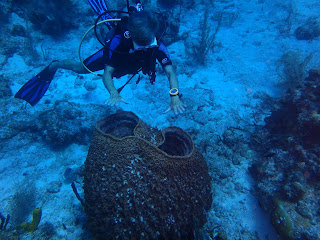The Cayman Islands lie south of central Cuba and a day's sail northwest of Jamaica. The island group is comprised of Grand Cayman, Cayman Brac, and Little Cayman. During this cruising season, we only had time to explore Grand Cayman, the largest and most populated of the group, where the capital city of Georgetown is located. We had flown there twice before to vacation and although we saw a remarkable increase in hotels and restaurants along its white sand beaches, were were not quite prepared to realize that even more had been erected since we last visited to satisfy their thirst for tourism dollars.
Our interest, of course, was to explore Grand Cayman's many dive sites. There are 234 well marked and maintained buoyed dive sites. Some popular sites along 7-Mile Beach have more than one buoy to accommodate more than one boat at a time.

The only challenge to diving in Grand Cayman on your own was finding a dive shop that was accessible by dinghy and willing to refill your air tanks. Luckily, after asking a lot of questions along the beach, we found one shop in Georgetown and another on the north coast of the island.





No comments:
Post a Comment